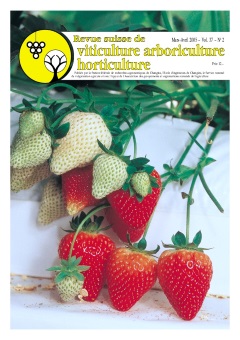
Issue 2 - March - April 2005
Abstract in open access
Consumers often complain about irregular sensory quality of strawberries (Fragaria x ananassa Duch). The aim of this study is to highlight to what extend the variation of the sensory quality can be influenced by cultivar, leaf/fruit ratio, harvest period and maturity stage of the fruits. The quality parameters analysed were the sugar, the aroma and the acid contents as well as the firmness of the fruits.
The different cultivars of strawberries showed significant variations concerning the quality parameters of the fruits, especially concerning the sugar content. The leaf/fruit ratio was a good indicator for explaining these cultivar differences. A higher leaf area per total strawberry yield increased the sugar content of the fruits. However, as the leaf area per g strawberries reached about 15 cm2, the increase in sugar content of the fruits stopped.
During the harvest period, the quality parameters of strawberries changed dramatically. Concerning the sugar content, variations of 3,5 °Brix for Ciflorette, Darselect and Marmolada and about 1,5 °Brix for Clery were recorded between the beginning and the end of the harvest. The maturity stage of the fruits had also a strong impact on quality parameters. During fruit ripening, the acid contents and firmness of the fruits decreased. In contrast, the sugar contents increased constantly from white to fully red fruits. However, the highest aroma content is reached at «fully red fruits» stage.
Key words: Fragaria x ananassa Duch, ripening, sensory quality, soluble solids, titrable acidity, volatile compounds.
Keywords:
E-Mail: christoph.carlen@agroscope.admin.ch
Adress: Agroscope, 1260 Changins/Nyon
Abstract in open access
An evaluation test of Chardonnay clones was set up on the experimental vineyard of Agroscope RAC Changins in Nyon (VD). Eight clones of the French Catalogue (76, 95, 96, 121, 122, 128, 131 and 548) were tested, as well as two clones selected in Changins. The study did not highlight important differences between the clones, except for the clone 548, which showed a lower production potential. It is a consequence of its very light sensitivity to coulure and millerandage. Between the wines, the differences were very low (on the analytical and on he sensory point of view). Clones RAC 17 and RAC 26 selected at Agroscope RAC Changins present a behaviour in the line of the other studied clones.
Key words: grapevine, Chardonnay, clones.
Keywords:
E-Mail: dominique.maigre@bluewin.ch
Adress: Agora
Abstract in open access
The use of oleoendosulfan as dormant insecticide spray in vineyards is being discussed. It could be replaced by diazinonoil. But doubts exist as for the harmlessness of this active ingredient on predatory mites. In 2002, several tests were set up in Western Switzerland to evaluate the level of toxicity of diazinonoil on predatory mites. The active ingredient appeared neutral in all plots. In all side effects tests of diazinonoil carried out in Switzerland these last years, diazinonoil was classified neutral to middle toxic to phytoseiids. These results make it possible to consider diazinonoil without serious consequences on biological control. In parallel, a study of the distribution of the various species of predatory mites confirmed that Typhlodromus pyri Scheut. is the most widespread species in Western Switzerland vineyards.
Key words: diazinonoil, side-effects, phytoseiids, vineyards.
Keywords:
E-Mail: christian.linder@agroscope.admin.ch
Adress: Agroscope, 1260 Changins/Nyon
Abstract in open access
A resistance survey was carried out by topical application of discriminating concentrations on diapausing larvae of codling moth collected in 2003 in Swiss orchards. They have confirmed the presence of more or less resistant strains of codling moth in many regions of the cantons Vaud, Valais, Geneva, Saint-Gall and Thurgovie. In the worst cases, cross-resistance concerns twelve out of the thirteen insecticides tested. In some other orchards, the pronounced loss of effectiveness seems to concern only some products, but the other insecticides also show undeniable signs of decline. Emamectin, a new insecticide still in development, was the only product not to be concerned by cross-resistance.
Key words: codling moth, Cydia pomonella, Switzerland, insecticide, resistance.
Keywords:
E-Mail: pierre-joseph.charmillot@acw.admin.ch
Adress: Agora

 Download of full issue
Download of full issue
 Download article
Download article